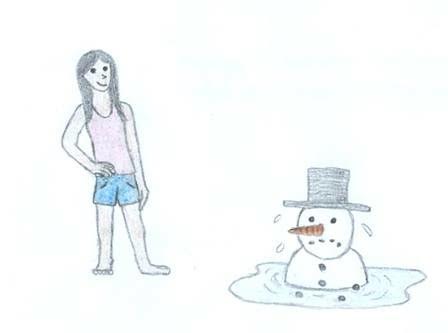A Gathering Storm: The Troubling Patterns Behind This Winter’s Weather

Art credits to Alicia Jen!
February 22, 2016
We all know and love the image of a white Christmas, with the holiday magic not just appearing in gift-wrapped boxes but also in the winter wonderland in our backyards. Unfortunately, the view outside our windows was a bit too colorful this Christmas – and it wasn’t just bad luck.
The whole month of December was unusually warm and lacking in snow; on some days, the temperature reached upwards of seventy degrees – better weather for an icy frappuccino than for a steaming latte. Finally, a snowstorm in late January broke the dry spell, but the whopping two-foot snowfall itself caused surprise. And a week later, Basking Ridge was back to sixty-degree weather and sad, melting snowmen. From one extreme to another, this winter is definitely going in the record books.
The weird weather has been drawing mixed emotions. Some people might have seen the higher temperatures as a relief from the bitter cold that usually keeps them cooped up indoors. Fiona He ’19 remarks, “I like the warmth, as ‘warm’ during these times isn’t that kind of blazing hot as it is during the summer, but more of a mild and convenient temperature.” Still, even she laments that “having some more snow days would have been really fun too.”
The January blizzard was a bit too much for those who wanted their snow days spread out more (and too late for those exhausted college applicants praying for a break). Overall, some people were happy, some people were sad, but almost everyone was a little confused.
If one looks into the science, these strange conditions aren’t completely out of the blue. Meteorologists had predicted that this winter would experience the peak of “El Niño,” a periodic climate event caused by the cyclic warming of the Pacific Ocean. Scientists are still unsure about what causes this phenomenon, but its effects are well documented: colder temperatures in Northern Europe, wetter conditions in South America, and warm, dry winters in the Northeastern United States. So, in a way, everything is going as expected.
However, this winter has been extreme even for an El Niño year; after all, who can remember the last time it hit seventy degrees in December? Rana Shahani ’16 sees it as a symptom of more alarming patterns, noting, “I think this winter weather goes to show that this world is really not in equilibrium!” The experts agree: satellite images from NASA show that this El Niño is one of the strongest recorded.
What makes an extreme event get even more extreme? The World Meteorological Organization (WMO) reports that this year’s El Niño has been magnified by anthropogenic climate change; the effects of global warming, combined with El Niño, has made 2015 the warmest year on record. People in New Jersey might appreciate the more comfortable winter temperatures, but El Niño is wreaking havoc in other parts of the world, from facilitating the spread of a mosquito-borne virus in South America to decimating food supplies in Africa. Scientists have also speculated that climate change is causing weather disasters to occur more frequently; when it does snow, there’s a lot of it. This hasn’t been lost on Shahani, who observes, “It’s pretty evident that something is amiss; we have this huge snowstorm, Hurricane Sandy, and increasing weather [events] all in span of my high school years.”
If climate change continues, the extreme weather of today could become the new normal going forward. A tranquil white Christmas might only exist on movie screens in a future when we have to contend with either sweltering heat or crippling storms. There probably aren’t mixed emotions about that; as WMO Secretary-General Michel Jarraud states, “This is all bad news for the planet.”

Lily Yang • Feb 29, 2016 at 11:09 am
As Leonardo Dicaprio said, global warming is an extremely pressing issue of our day. The weather this year was no coincidence, and to prevent our suffering we should take care of our planet.